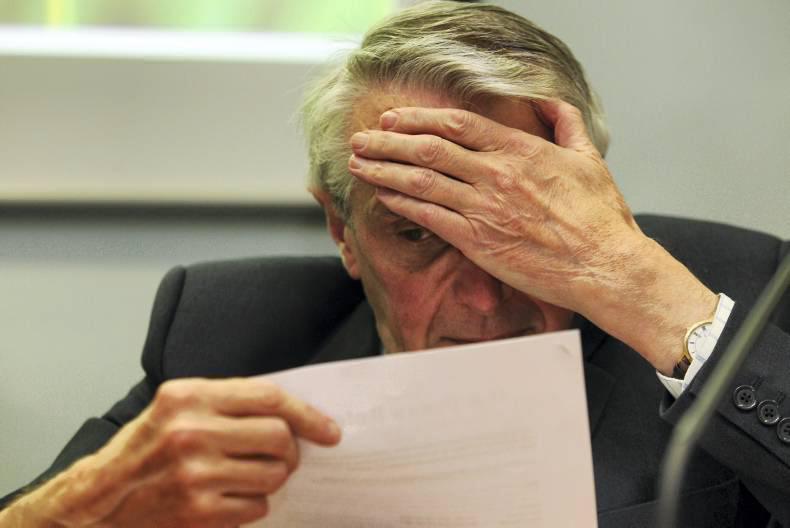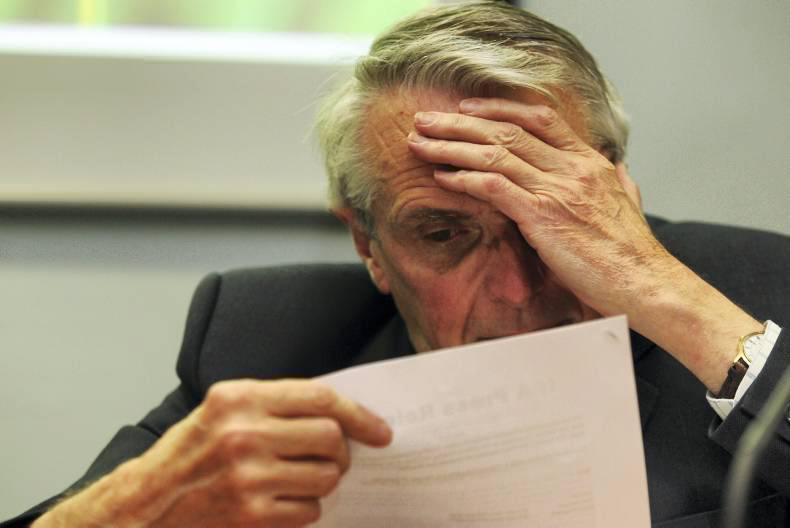One of the requests made of Con Lucey when he was asked to draw up his report and recommendations on the IFA was to examine the remuneration package of former general secretary Pat Smith from his appointment in 2009 to his departure in 2015.
The report shows Smith’s remuneration for each year (see Table 2). It is broken down into basic salary, yearly bonus where paid, IFA Telecom fees, company car and pension contributions. The report also identifies the various presidents and treasurers who set Pat Smith’s yearly remuneration.
Con Lucey said that as a reference point, the initial salary of the IFA general secretary was 7% higher than the salary of a secretary general in a Government department.
He said that the €75,000 bonus paid to Pat Smith in 2009, equal to 30% of salary, was in his opinion relatively high bearing in mind that no measurable criteria were set, other than a requirement for “outstanding or very satisfactory performance”.
Negotiated
In 2010, Pat Smith negotiated to have €45,000 of his bonus converted to salary, and also to make this pensionable. As a result, in that year his basic salary rose to €295,000 while his bonus reduced to €30,000.
“The decision to convert, on a permanent basis, €45,000 bonus to salary and to make this pensionable involved a significant ongoing cost to IFA,” Lucey states.
“This arrangement was unique to Pat Smith. It is not clear whether the cost implications of this decision were fully understood by the president and treasurer of the time.”
He says: “Under agreements in 2012 and 2013, for reasons that are unclear, further increases were granted to Pat Smith in his level of bonus.”
Smith received fees from IFA Telecom starting in 2011. Lucey says: “The payment of fees from IFA Telecom to the general secretary, who was already well-remunerated, seems unjustified in my opinion, and these funds should have remained within IFA.”
In 2014 and 2015, the payment of the bonus and the IFA Telecom fees were opposed by the national treasurer, Jer Bergin, pending the establishment of a new remuneration committee.
Meanwhile, for participation on the boards of Farmer Business Developments and FBD Trust, Pat Smith received €6,600 and €5,000 per annum respectively.
On pension, Con Lucey explained that Smith was a member of IFA’s then defined benefit scheme in 2009 and 2010. This scheme was closed in 2011 – a trend mirrored across the private sector – with a defined contribution scheme put in place.
In 2009, Pat Smith negotiated with the outgoing president and treasurer to have a further pension to provide for early retirement (Top-Hat). Under this agreement, IFA would contribute 5% in 2010 rising to 10% for all subsequent years.
Commenting, Lucey said that the IFA contribution to the new DC scheme for former DB staff is relatively generous, and much higher than that applying to staff recruited after 2005.
“As regards the Top-Hat scheme, Pat Smith was already in a very favourable pension position and it is difficult to see the justification for the funding by IFA of a new scheme uniquely for his benefit.”
Con Lucey does not make specific recommendations on what the next general secretary of IFA should be paid. Instead, he maintains and expands his 2014 recommendation that a remuneration committee be established to set pay for top office holders in the organisation.
He also recommended that membership of the remuneration committee should be drawn from senior elected officers, with the possibility of an external expert as well. It should not include the president and general secretary.
He said: “I continue to hold the view that the president should not be involved in determining the remuneration of the general secretary for two reasons.
“First, there is a risk that in a committee of three IFA officers, the president’s position may be given disproportionate weight. Second, the president and general secretary should work in a close complimentary manner, and are likely to be in contact almost on a daily basis. For one to have to set the remuneration of the other in the context of IFA may not be a desirable situation, in my view.” He also recommends that the external expert on the committee should be someone with specialist knowledge of pay levels in appropriate sectors in the market place.
“The type of expert I have in mind is a person that could provide the three IFA members with information and advice on prevailing pay levels in the public and private services sectors.”
Con Lucey states that under a new financial reporting standard, FRS 102, IFA needs to disclose in a single figure the total transfers to “key management personnel”, in its accounts for year-end March 2016, alongside comparable data for 2015. He notes that the issue of defining key management personnel remains unresolved. He recommends that it should be either:
The general secretary (or future equivalent if management structures are revised).The general secretary plus the president. Read more
Full coverage: Con Lucey report
One of the requests made of Con Lucey when he was asked to draw up his report and recommendations on the IFA was to examine the remuneration package of former general secretary Pat Smith from his appointment in 2009 to his departure in 2015.
The report shows Smith’s remuneration for each year (see Table 2). It is broken down into basic salary, yearly bonus where paid, IFA Telecom fees, company car and pension contributions. The report also identifies the various presidents and treasurers who set Pat Smith’s yearly remuneration.
Con Lucey said that as a reference point, the initial salary of the IFA general secretary was 7% higher than the salary of a secretary general in a Government department.
He said that the €75,000 bonus paid to Pat Smith in 2009, equal to 30% of salary, was in his opinion relatively high bearing in mind that no measurable criteria were set, other than a requirement for “outstanding or very satisfactory performance”.
Negotiated
In 2010, Pat Smith negotiated to have €45,000 of his bonus converted to salary, and also to make this pensionable. As a result, in that year his basic salary rose to €295,000 while his bonus reduced to €30,000.
“The decision to convert, on a permanent basis, €45,000 bonus to salary and to make this pensionable involved a significant ongoing cost to IFA,” Lucey states.
“This arrangement was unique to Pat Smith. It is not clear whether the cost implications of this decision were fully understood by the president and treasurer of the time.”
He says: “Under agreements in 2012 and 2013, for reasons that are unclear, further increases were granted to Pat Smith in his level of bonus.”
Smith received fees from IFA Telecom starting in 2011. Lucey says: “The payment of fees from IFA Telecom to the general secretary, who was already well-remunerated, seems unjustified in my opinion, and these funds should have remained within IFA.”
In 2014 and 2015, the payment of the bonus and the IFA Telecom fees were opposed by the national treasurer, Jer Bergin, pending the establishment of a new remuneration committee.
Meanwhile, for participation on the boards of Farmer Business Developments and FBD Trust, Pat Smith received €6,600 and €5,000 per annum respectively.
On pension, Con Lucey explained that Smith was a member of IFA’s then defined benefit scheme in 2009 and 2010. This scheme was closed in 2011 – a trend mirrored across the private sector – with a defined contribution scheme put in place.
In 2009, Pat Smith negotiated with the outgoing president and treasurer to have a further pension to provide for early retirement (Top-Hat). Under this agreement, IFA would contribute 5% in 2010 rising to 10% for all subsequent years.
Commenting, Lucey said that the IFA contribution to the new DC scheme for former DB staff is relatively generous, and much higher than that applying to staff recruited after 2005.
“As regards the Top-Hat scheme, Pat Smith was already in a very favourable pension position and it is difficult to see the justification for the funding by IFA of a new scheme uniquely for his benefit.”
Con Lucey does not make specific recommendations on what the next general secretary of IFA should be paid. Instead, he maintains and expands his 2014 recommendation that a remuneration committee be established to set pay for top office holders in the organisation.
He also recommended that membership of the remuneration committee should be drawn from senior elected officers, with the possibility of an external expert as well. It should not include the president and general secretary.
He said: “I continue to hold the view that the president should not be involved in determining the remuneration of the general secretary for two reasons.
“First, there is a risk that in a committee of three IFA officers, the president’s position may be given disproportionate weight. Second, the president and general secretary should work in a close complimentary manner, and are likely to be in contact almost on a daily basis. For one to have to set the remuneration of the other in the context of IFA may not be a desirable situation, in my view.” He also recommends that the external expert on the committee should be someone with specialist knowledge of pay levels in appropriate sectors in the market place.
“The type of expert I have in mind is a person that could provide the three IFA members with information and advice on prevailing pay levels in the public and private services sectors.”
Con Lucey states that under a new financial reporting standard, FRS 102, IFA needs to disclose in a single figure the total transfers to “key management personnel”, in its accounts for year-end March 2016, alongside comparable data for 2015. He notes that the issue of defining key management personnel remains unresolved. He recommends that it should be either:
The general secretary (or future equivalent if management structures are revised).The general secretary plus the president. Read more
Full coverage: Con Lucey report










SHARING OPTIONS